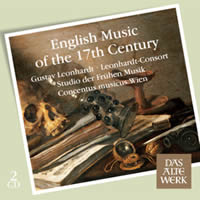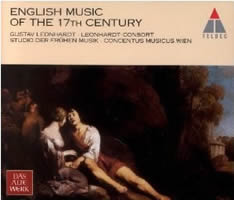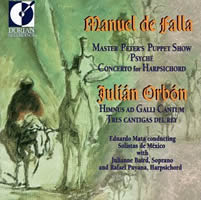Four Centuries Apart 2.
|
Walt Mundkowsky [June 2008.]
“English Music of the 17th Century.” ANON., William LAWES, Orlando GIBBONS, Giles FARNABY, William BYRD, William RANDALL, Thomas TOMKINS, Thomas MORLEY, William TISDALE, John BULL, John COPRARIO, Tobias HUME, Thomas WEELKES, John WARD, John WILSON, John HINGESTON, Thomas CAMPION, Matthew LOCKE, Thomas LUPO, Robert JOHNSON: Consort Music, Keyboard Music, Songs. Gustav Leonhardt (virginal, hpschd, org), Leonhardt Consort, Leonhardt (dir.); Concentus Musicus Wien; Andrea von Ramm (m-sop, organetto), Grayston Burgess (cntrten), Willard Cobb, Nigel Rogers (ten), Karl Heinz Klein (bar), Studio der Frühen Musik, Thomas Binkley (lute and dir.). Teldec Das Alte Werk 2564 69765 4 (2 CDs) (http://www.warnerclassicsandjazz.com/). Distributed in the US by Warner Classics (http://www.warnerclassicsandjazz.com/). I’m pleased to welcome this 1995 compilation (of 1965-67 work) back to the catalog. Except for Leonhardt’s use of historical keyboards or modern copies, it can’t be called pioneering — the principals had done this repertory for some time. Four decades on, the sound holds up better than some of the performances. In ascending order of merit: Songs Binkley’s major impact lay in the Medieval sphere. As noted before, his touch in this era is on the bald, direct side. The nine songs cover the standard turf — humor (Hume’s “Tobacco”), lament (Coprario’s “My joy is dead”), melancholy (Weelkes’ “Cease sorrows now”), romance idealized (“Deerest love”) and not (Campion’s “Come, you pretty false-eyed wanton”). Robert Johnson, Shakespeare’s favorite composer, defeats routine with “Care-charming sleep.” Consort Music England’s viol consort tradition contains the most profound chamber music prior to the string quartet. I’m unsure how many would reach that conclusion based on the smoothed-out playing displayed here, but it’s effective enough to highlight the genre as deserving further study. (What it did for this grad student.) The Gibbons and Lupo Fantasias barely hint at their riches to be mined later, and a Locke Suite needs the snapping shifts that reflect his acerbic, restless nature. In the Concentus Musicus set, the ringer is John Ward (1571-1638), who’s received occasional attention (one all-Ward viols album exists, from 2003). His Fantasia boasts a subtly wrought structure and majestic sonority — worth repeating on the spot. Half of the “English Consort Music” CD in the Leonhardt Edition appears — most of the Lawes and the Byrd items. This group’s leader certainly responds more variously than his Viennese counterpart, with deliberate intros and forte climaxes. Even so, Lawes’ exotic harmonies and tipsy phrasing get played up these days. Byrd is harder to slant — clean contrapuntal busyness and firm melodies — so Leonhardt seems nearer current practice there. Keyboard Music Several Leonhardt gems here haven’t been surpassed. He guides Bull’s Hexachord Fantasia unerringly, from profuse developments to grand conclusion. (Mastery of Sweelinck’s similarly themed piece no doubt helps.) Tomkins’ A Sad Pavan for these Distracted Times (so relevant today) is moving in its restraint — no boohooing necessary. In 1967 Leonhardt was a more propulsive artist than he eventually became; witness the intricate fingerwork on Morley’s Nancie, or the lilt and sheer fun of Farnaby’s Spagnioletta. Not everything succeeds. Two transcriptions of Dowland (Randall) do the English Orpheus no favors, being overly ornamented (Lachrymae) and then brutally forthright (Galliard “Can she excuse my wrongs”). Leonhardt’s programming at least makes them a conventional pair of dances.
Manuel de FALLA: Master Peter’s Puppet Show* (1919-22); Psyché (1924); Concerto for Harpsichord (1923-26). Julíán ORBÓN: Himnus ad Galli Cantum (1956); Tres cantigas del rey (1960). Lourdes Ambriz*, Julianne Baird (sop), Miguel Cortez* (ten), William Alvarado* (bar), Rafael Puyana (hpschd); Solistas de México, Eduardo Mata (cond.). Dorian DOR-90214 (http://www.dorian.com/). Available from ArkivMusic (http://www.arkivmusic.com/). This 1995 CD features three prime 20th-century works involving harpsichord and two substantial fillers. With superior Dorian sound, a potent and highly enjoyable release. Master Peter’s Puppet Show Falla composed it as “a devout homage to the glory of Miguel de Cervantes.” While stagecraft would seem an essential element, the concert version is much better known. Master Peter interrupts to decry his boy narrator’s florid excesses (“avoid dangerous counterpoint”) and to protest Don Quixote’s rash defense of the fleeing lovers. Mata gives the lyrical episodes a special charm, which lends their eventual demise a sharp slap. The clear, phenomenally agile soprano of Lourdes Ambriz is very winning as the patter-addicted narrator. Thankfully she has most of the lines, for Cortez and Alvarado don’t nail Master Peter’s outrage and the Don’s bluster with equivalent gusto. Puyana’s harpsichord is limited to continuo gestures. Concerto for Harpsichord This is Falla’s greatest achievement; he finished nothing comparable in the remaining 20 years of his life, nor is the music’s dry, aristocratic mien much in evidence among his earlier output. Landowska commissioned the piece and hated it. (Not enough solo spotlighting or virtuoso display?) So it’s intriguing that Puyana, a famous pupil of hers, should be the name harpsichordist most identified with it. (He taped it for a 1972 Philips LP, SAL 6505 001, under Mackerras.) The granite-tough slow movement is accorded the solemnity and weight of a sacred procession (in the score Falla wrote, “A Dom. MCMXXVI. In Festo Corporis Christi”). Here and elsewhere, the other instruments (flute, oboe, clarinet, violin, cello) often ply the extremes of their registers, and Mata nicely relates such inlay work to Puppet Show (which I hadn’t considered). I eagerly awaited Igor Kipnis’ take with Boulez and New York Philharmonic members (in two separate Sony packages), but it’s an uninspired run-through — evidently not something Boulez cares about. Tres cantigas del rey Even more than the Concerto, this is music Puyana owns (also on that Philips LP). In just 7:39, Orbón keeps faith with his source (Alfonso X’s 13th-century Cantigas de Santa María) while being wholly modern. Whether by chance or design, Tres cantigas mirrors the layout of Falla’s Concerto — a spiky early-Baroque opener (Cantiga 65), elevated and intense slow movement (134), animated and untroubled finale (133). Baird is a rare soprano with lengthy early-music credentials yet some operatic heft in her delivery — perfect for this assignment. A string quartet supports or complicates the harpsichord’s line beautifully. Two Others Orbón’s Himnus ad Galli Cantum (Hymn to the Rooster’s Song) is the more immediately arresting. Based on a fourth-century poem (Aurelius Prudentius), it’s almost a dry run for the austere Tres cantigas down to the scoring (flute, oboe, harp, string quartet). In Psyché Falla imagines a 5:05 interlude for the 18th-century Spanish court. Wispy and delicate, it has always struck me as more French in character. Baird is well up to the refined demands of both.
[More Four Centuries Apart, Walt Mundkowsky]
[Previous Article:
Words Fail Me 8.]
[Next Article:
Artur Schnabel’s “Love Affair”]
|


